
Donna’s Road to Multiple Myeloma Diagnosis and Transplants
Donna discusses her multiple myeloma diagnosis and the start of her treatment, while Dr Gasparetto educates on the importance of transplants.
Episodes in this series

Cristina Gasparetto, MD: Now we can get more specific when myeloma is suspected, like in your situation. You went to a hematologist, and then what did they tell you? How did they tell you that you were in myeloma? You are a young woman, very active—what’s happening next?
Donna Kidder: It was an unusual situation. He said, “Do you know why you’re here?” And I said, “I think I have multiple myeloma.” And he looked at his nurse and said, can you believe she figured it out? After I talked with him, I went home and talked to a number of people. I had a friend who had chosen a particular line of therapy, and a doctor, in Arkansas. As you know, I went to Arkansas for my initial treatments.
Cristina Gasparetto, MD: Yeah, so you did a little research. A lot of people google. There are different institutions and different philosophies. Of course, Little Rock the University of Arkansas for Medical Sciences Winthrop P. Rockefeller Cancer Institute is very famous with its expert team at the Myeloma Center. So you decided to go there. It’s a difficult situation when you tell a patient for the first time that you do have myeloma. It’s a difficult conversation because myeloma still is a difficult cancer to live with. If you have a different type of cancer caught earlier, you have a higher chance of being cured. Think about any type of cancer—with resection, early intervention. With myeloma, even though your cancer was diagnosed relatively early, you really didn’t have the major CRAB [hypercalcemia, renal insufficiency, anemia, bone lesions] symptoms I described earlier.
You have to live the rest of your life with this disease. There are not many patients who are myeloma-free. We buy time with the therapy, and the therapy has an impact. We’ll talk about therapy in the survival of patients, but you have to stay on therapy, off and on, for the rest of your life. So it’s a very difficult conversation. I tell my patients that there are so many new options and many new strategies, and we just have to set up goals and balance therapy with quality of life. The first thing I say is that we have to achieve a complete remission. We have to eliminate all the myeloma cells. I still recommend high-dose therapy after initial induction. I think you did that when you were first diagnosed. Back then, almost 10 years ago, the therapy we were using to prepare a patient for transplant—and we can talk why transplant is still important, but it was a little different from the therapy we use now. Now we use a combination of new targeted therapy. The most commonly used, a combination of bortezomib-lenalidomide, is given by mouth. Bortezomib is a shot. And dexamethasone. Very often we have a fourth drug: Darzalex, daratumumab. The intent of the first-line therapy is to kill myeloma very quickly and to achieve the deeper response as soon as possible. Some patients stay on therapy and achieve the deeper response with continuation of therapy. Some decide to go to transplant. You were treated with a combination of these drugs, then you proceeded to transplant. Do you remember what type of response you had after your initial therapy?
Donna Kidder: Well, I didn’t reach zero minimal residual disease until after both transplants. Because I had two transplants.
Cristina Gasparetto, MD: You had 2 transplants.
Donna Kidder: Yeah. And I had follow-up therapy. So I had to go through the entire thing before I finally reached a zero minimal residual disease. It cut it—it dropped back—but I didn’t eliminate it until I completed it. It was a long process.
Cristina Gasparetto, MD: Let me explain, Donna, what minimal residual disease is. When I started to treat patients with myeloma many years ago, we were content with any type of response, and we were using old-fashioned chemotherapy to eliminate the myeloma cells very quickly. It was clear with time that achieving deeper responses, like a complete remission, translated to a better outcome, with longer durability of remission. Now we’re not even content with a complete remission. Complete remission means that the antibody that you’re producing, the marker of your disease, is not further detected in your serum and urine. If we do a bone marrow, then there are zero myeloma. Now we go even deeper. The minimal residual disease is when we analyze a few million soft cells by different methodology: By flow analysis or next-generation sequencing, we make sure you don’t have detected myeloma at the 10-5. Now we use a 10-6 threshold. So we’re trying to eliminate the myeloma. The initial therapy brings us down to the level but not completely, as you mentioned. You had two transplants to go down. Some patients require additional therapy.
This transcript has been edited for clarity.






